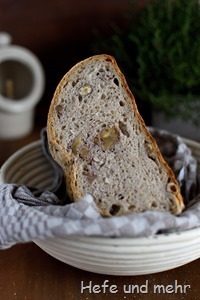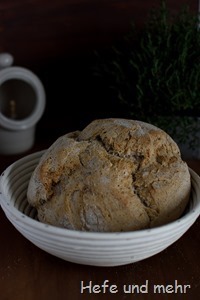 After a mainly cold and rainy summer, the weather turned for some days just when school started. But this was just the last glimpse of summer we got. With the beginning of September it changed again and since then we have typical autumn weather – cold, sometimes rain, sometimes sun. When I drive to work I can see the valley filled with mist– it looks like little clouds snuggling into their beds before sun is waking them for the day. For me autumn is always the season to bake nut breads. And so I bake not only the dark spelt, nut & fruit in the wood fired oven last week, but as well a light spelt bread with hazelnuts and walnuts.
After a mainly cold and rainy summer, the weather turned for some days just when school started. But this was just the last glimpse of summer we got. With the beginning of September it changed again and since then we have typical autumn weather – cold, sometimes rain, sometimes sun. When I drive to work I can see the valley filled with mist– it looks like little clouds snuggling into their beds before sun is waking them for the day. For me autumn is always the season to bake nut breads. And so I bake not only the dark spelt, nut & fruit in the wood fired oven last week, but as well a light spelt bread with hazelnuts and walnuts.
A deep flavour is archived by the combination of a spelt sourdough, a rye sourdough and a sweet starter. And due to the three lively sourdough adding yeast is theoretically not necessary. But as the community oven is not waiting for anyone I used a tiny bit of commercial yeast to keep fermentation well controlled and well fitted in the time schedule. And so et the end everything worked as planned: The oven spring was strong, the crust turned out crunchy and the crumb was fluffy. A perfect day for calm autumn days.
Autumn Bread
yields 2 Breads
- 100g Whole spelt flour
- 100g Water
- 10g Sourdough
Rye sourdough
- 100g Rye flour Type 1150
- 100g Water
- 10g sourdough
- 100g Sweet Starter
- 100g Spelt flourType 630
- 50g Water
Dough
- Rye sourdough
- Spelt Sourdough
- Sweet starter
- 540g Spelt flour Type 630
- 100g Rye flour Type 1150
- 5g psyllium husk
- 250g Water
- 150g Milk
- 20g Salt
- 5g enzyme active Malt
- (3g yeast, optional)
Nuts
- 100g Walnuts
- 100g Hazelnuts
Mix the ingredients for the sourdoughs and ferment for 14-16 hours at room temperature.
Mix the ingredients of the sweet starter and let it rise for 2-4 hours at 30°C until it doubles its volume. Store in fridge until the next morning.
The next morning knead all ingredients 7 min at slow speed and another 2min at fast speed.Add the nuts and knead until well combined.
Ferment the dough for 2 hours total, folding after 45 and 90 min.
Form two round loaves and place it seam side down in the proofing basket.
Proof for 60 min.
In the meantime heat oven and baking stone to 250°C.
Bake with steam for 60 min, reducing the heat to 180°C after 10 min.
Deutsch




Hallo Stefanie,
Meine süsser Starter ist im Moment im Nirwana….
Du schreibst oben einfach mit einem Biga ersetzen: Das wäre dann ca. 64g Mehl, 36g Wasser und 0.6g Hefe.
Jetzt weiss ich nicht mehr weiter. Lass ich den Biga zuerst reifen (ca. 12 Std.) und gebe danach 100g Dinkelmehl und 50g Wasser bei und lasse dies wiederum wie oben im Rezept beschrieben bis zum anderen Morgen reifen.
oder
mische ich 100g Dinkelmehl und 50g Wasser mit den 64 g Mehl, 36 g Wasser und 0.6 g Hefe vom Biga und lasse alles bis zum anderen Morgen reifen?
Vielen Dank für Deine Hilfe
Elisabeth
@Elisabeth: Die Biga wird in einem Rutsch angesetzt: 165g Mehl und 82g Wasser und 0,5g Hefe verkneten und für mindestens 16 Stunden in den Kühlschrank zum Reifen stellen.
Hallo Stefanie,
ich habe nur Dinkel Sauerteig, brauche ich zwingend auch Roggensauer? Kann ich Roggenmehl mit Dinkelsauer versäuern? Das Brot sieht sehr lecker aus.
@Christine: Ich habe die meiste Zeit auch nur einen Weizen/Dinkel-Sauerteig, und setze damit den Roggensauerteig an. Er bleibt dann ein wenig milder als ein Sauerteig, der langfristig mit Roggenmehl gefüttert wird, wird aber dennoch kräftiger im Aroma als ein Sauerteig mit Dinkel- oder Weizenmehl.
Hallo Stefanie,
das Brot macht ein sehr guten Eindruck aber was mich dabei interessiert sind die Flohsamenschalen.
Nach welchen Bemessungsgrundlagen kommen die rein, einmal 5g einmal 20g oder 50g je nach Brot verschieden. Ich hab nichts gegen die Zutat, wie verändern die Flohschalen das Wasser-Teig-Mehl Verhältnis.
Vielen Dank für eine Antwort.
Rudolf
@Rudolf: Ich verwende 0,5-2% Flohsamenschalen bezogen auf die Mehlmenge, wobei mir 0,5-1% beim Mundgefühl am Besten gefällt. 20g auf 1kg Mehl würden dabei 2% entsprechen. 50g erscheint mir sehr viel, solche Mengen kenne ich nur von glutenfreien Mehlen, wo Flohsamenschale als Bindemittel verwendet wird.
Wieviel ich für “normale” Brote verwende, kommt auf die Wassermenge an, die ich binden möchte. 10g Flohsamenschalen binden 80g Wasser. Alternativ kann man aber auch mit einem Kochstück arbeiten.
Liebe Stefanie,
gute Antwort, damit kann man arbeiten!
Gruß, Annette
@Annette: Freut mich 😀
Oh wie fein!
Leider besitze ich immer noch keinen süßen Starter…
Kann ich das Brot auch mit einer Biga und mehr hefe backen? Würde das auch gehen?
Liebe Grüße und schönen Sonntag
Suanne
@Susanne: Klar kann man das. Setz einfach so viel Biga an, dass es der Menge an süßem Starter entspricht und erhöhe die Hefemenge auf 10g, dann passt das auch.